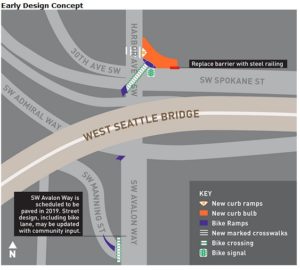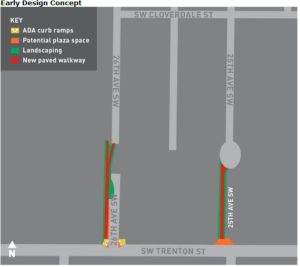Downtown and South Lake Union MHA
On Tuesday, 3/21/2017, the Planning, Land Use and Zoning Committee discussed eight amendments to the proposed South Lake Union (SLU) and Downtown Mandatory Housing Affordability (MHA) legislation. The amendments ranged from a. providing a carrot to developers not covered by MHA (because their projects are already through the design process) to voluntarily participate in the MHA affordable housing program to b. requiring developers to develop transportation management plans to c. my own proposal to increase the affordable housing obligations of developers in SLU and Downtown. There was no vote on my amendment and several of the others. The Full Council is scheduled to vote on these amendments and the final bill on Monday, 4/10/2017 at 2pm.
The basic tenet of the MHA affordable housing program is that we can legally require developers to contribute to affordable housing when we change zoning to grant some additional zoning capacity to build taller. The MHA program proposes to “capture the value of the upzone” in the form of an affordable housing obligation on developers. The broader MHA Program has two components: (1) a program that applies to commercial development, Mandatory Housing Affordability – Commercial (MHA-C) and (2) a program that applies to residential development, Mandatory Housing Affordability-Residential (MHA-R). This is the approach that the Council passed last month with the University District MHA rezones and it’s the approach proposed for all of the Citywide MHA rezones. It is not the approach proposed for the SLU and Downtown MHA-R program. Here is some background on why there is a different approach proposed and why I don’t think it’s the best deal we can strike for affordable housing.
- How were the proposed MHA-R housing affordability requirements derived for Downtown and South Lake Union (SLU) MHA?
The special requirements for SLU/Downtown were laid out in the Grand Bargain.
“For high-rise areas (DT/SLU/HR-First Hill), residential buildings would be given an extra 1,000 sf/floor: (i) this increment would be charged at the current incentive zoning rate ($22.65/square foot); and (ii) this increment would be viewed as part of mandatory incentive zoning, so that value of this available increment would be paid towards affordable housing whether the increment was used.”
- What does this mean for affordable housing if enacted in SLU and downtown?
The $22.65/square foot incentive zoning program fee extended to the extra residential floor area granted through the upzone and divided across the entire building would result in MHA-R fees for SLU and Downtown that range from $5.55 – $13.75 per square foot and performance requirements that range from 2.1% – 6% of all units in a building. This is a smaller requirement than if the same formula that was used for the University District and proposed for the rest of the City was also used in SLU and downtown. Consequently, developers in Downtown and South Lake Union would pay a fee that recaptures less of the value conveyed through the upzone than their counterparts outside of Downtown and SLU.
- Were the Incentive Zoning requirements passed in 2013 based on the value of the upzone?
The proposal for the Downtown and South Lake Union MHA program is not based on the value conveyed by the 2013 upzone, which increased heights for residential development in most areas of South lake Union from 85-240 feet. Rather, the payment and performance requirements reflected what developers and property owners convinced the 2013 Council was a good incentive for them to build.
- How much higher did our consultant at the time say the incentive zoning fees could be set with still guaranteeing a good “return on equity” for investors and developers?
In 2013, Spectrum Development Solutions estimated that the City could establish a voluntary in-lieu incentive zoning payment almost four times greater than was adopted with upzones in the South Lake Union area and still allow development to achieve an economic rate of return that would attract investment. While the Spectrum study was based on an assumption that units provided through incentive zoning would be affordable to households with somewhat higher incomes than proposed under the MHA-R framework, the analysis indicates that there is uncaptured value from the currently proposed upzone that could be reflected in higher payment and performance requirements for MHA-R.
- How might production proposed for Downtown/ SLU under the MHA-R program change, if the Council used the same methodology for all the MHA proposed upzones?
If we were to use the formula proposed for all the other upzones in the proposed SLU/Downtown upzone we could build approximately 320-450 more affordable housing units over a 20 year period. The additional $1.3 – $1.9 million a year in fees could leverage other housing funds (up to a 1-3 leverage) potentially a total as much as $3.9 million – $5.7 million more a year.
Here are some details using the Office of Planning and Community Development’s assumptions for how growth downtown would be distributed among zones and uses under two scenarios as compared to the current proposal.
Scenario 1 – Using capitalized revenue methodology proposed for outside of Downtown to establish a payment of $12.80 in the Downtown and South Lake Union Urban Centers based on a 5% performance requirement.
Scenario 2 – Same as Scenario 1 above, but assuming current market rents of $3.04/gsf, which would establish a payment of $14.20/gsf.
| In-Lieu Payments | Leveraged Amount | Estimated Production with leveraged resources | |
| Mayor’s Current Proposal | $ 59,362,000.00 | $ 133,564,500.00 | 742 Units |
| Scenario 1 ($12.80 s.f.) | $ 87,776,000.00 | $ 197,496,000.00 | 1,087 Units |
| Scenario 2 ($14.20 s.f.) | $ 97,376,000.00 | $ 219,096,000.00 | 1,217 units |
These modest increases in payment and performance requirements go further to address the affordable housing crisis and use the private investment of developers to leverage significant additional affordable housing dollars, all while still providing an economic incentive for developers. They also ensure a more consistent policy framework across the entire MHA Affordable Housing Program – so that we can say that in all places the program applies we are capturing the value of the additional development capacity that the City is granting and turning it into affordable housing.
South Park Crime and Public Safety Survey
The Seattle Neighborhood Group is conducting a Crime and Public Safety Survey about the 8th and Cloverdale area. You can take the survey online here, or call 206-322-1161 between 10 a.m. and 3 p.m. on weekdays. The Seattle Neighborhood Group has worked on neighborhood safety problems over the last 25 years.
Harbor Ave SW and SW Spokane St Intersection Improvements
 SDOT is taking public comment for Harbor Ave SW and SW Spokane St Intersection Improvements, funded through the 2016 Neighborhood Street Fund awards.
SDOT is taking public comment for Harbor Ave SW and SW Spokane St Intersection Improvements, funded through the 2016 Neighborhood Street Fund awards.
The Early Design Concept is shown on the project webpage, and copied on the right. SDOT is asking for comments about the design concept, and your experiences there. You can send comments to NSFHarborandSpokane@seattle.gov.
Here’s a March 2017 project update, and the SDOT’s review of the 2016 grant application.
You can sign up here for e-mail updates. Design is planned for 2017, and construction in 2018.
Chief Sealth High School Walkway Improvements
 SDOT is also taking comments on walkway improvements to enhance access to Chief Sealth High School, also funded through the Neighborhood Street Fund. The project would install two 10-foot wide walkways on 25th SW and 26th SW to the cul-de-sacs to the north, and add pedestrian lights, and provide a better connection between Westwood Village, transit stops, and Chief Sealth High School.
SDOT is also taking comments on walkway improvements to enhance access to Chief Sealth High School, also funded through the Neighborhood Street Fund. The project would install two 10-foot wide walkways on 25th SW and 26th SW to the cul-de-sacs to the north, and add pedestrian lights, and provide a better connection between Westwood Village, transit stops, and Chief Sealth High School.
The Early Design Concept is shown on the project webpage, and copied below. SDOT is asking for comments about the design concept, and your experiences there. You can send comments to NSFHarborandSpokane@seattle.gov.
Here’s a March 2017 project update, and the SDOT’s review of the 2016 grant application.
You can sign up here for e-mail updates. Design is planned for 2017, and construction in 2018.
A new round of Neighborhood Street Fund applications is scheduled for 2019.

